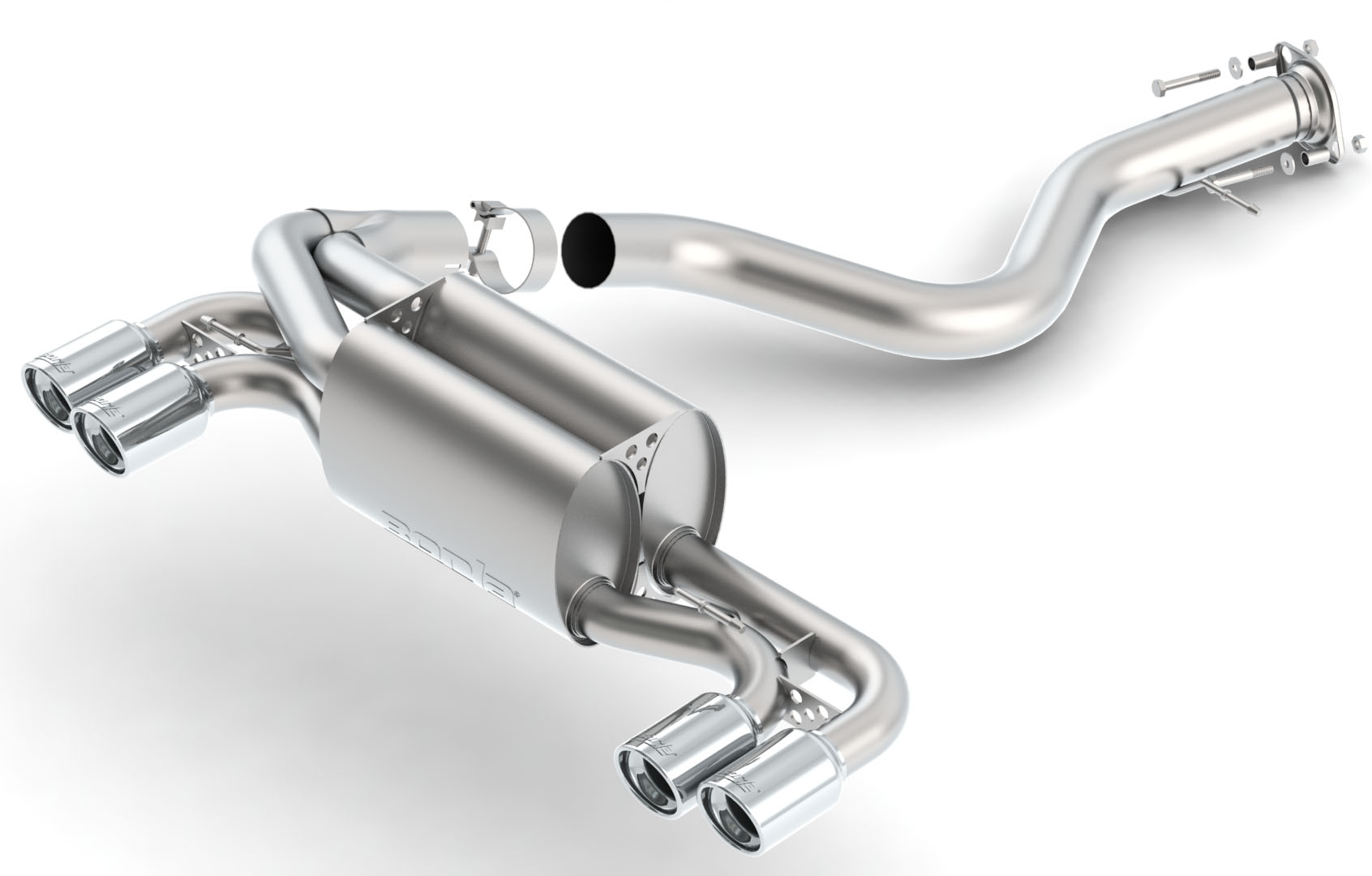Anwendung der Poliertechnik bei Metallkomponenten von Kfz-Abgasanlagen
8. Januar 2024
Anwendung der Poliertechnik bei Metallkomponenten von Kfz-Abgasanlagen
Im modernen Automobilbau ist die Abgasanlage nicht nur ein Kanal für Motorabgase, sondern ein zentrales Bauteil, das sowohl die Fahrzeugleistung als auch die Ästhetik beeinflusst. Um die Optik und Langlebigkeit von Automobilen zu verbessern, spielt die Poliertechnologie bei den Metallkomponenten von Abgasanlagen eine entscheidende Rolle. Nachfolgend finden Sie eine detaillierte Beschreibung der Anwendung der Poliertechnologie bei den Metallkomponenten von Automobilabgasanlagen:

- Verbesserung der visuellen Qualität:
– Oxidationsentfernung: Die Poliertechnologie entfernt gekonnt Oxidation, Schmutz und Unvollkommenheiten von der Metalloberfläche und verleiht den Metallkomponenten des Abgassystems ein glatteres und edleres Aussehen.
– Gleichmäßige Oberfläche: Der Prozess erzeugt eine gleichmäßig glatte Oberfläche, die zu einem eleganten und polierten Aussehen beiträgt und so die optische Qualität der Abgasanlage steigert. - Verbesserung der Korrosionsbeständigkeit:
– Bildung einer Schutzschicht: Durch das Polieren entsteht eine mikroskopisch glatte Oberfläche und eine Schutzschicht, die die Korrosionsgefahr verringert. Diese Schicht wirkt als Barriere gegen Umwelteinflüsse wie Feuchtigkeit, Salz und andere korrosive Elemente.
– Chemische Beständigkeit: Die polierte Metalloberfläche weist eine erhöhte Beständigkeit gegen chemische Erosion auf, ein wichtiger Aspekt für Abgassysteme, die potenziell korrosiven Elementen in den Abgasen ausgesetzt sind. - Reflektiertes Licht und Designüberlegungen:
Verbesserte Reflektivität: Eine polierte Oberfläche reflektiert Licht effektiver und sorgt so für einen eindrucksvollen optischen Effekt. Designer können die Politur gezielt einsetzen, um bestimmte Merkmale hervorzuheben und so den funktionalen und ästhetischen Wert der Abgasanlage zu steigern.
– Designflexibilität: Die Poliertechnologie bietet Designern mehr Flexibilität und ermöglicht es ihnen, die visuelle Wirkung von Metalloberflächen im Abgassystem zu berücksichtigen und zur allgemeinen ästhetischen Attraktivität des Fahrzeugs beizutragen. - Verlängerung der Lebensdauer der Komponenten:
– Korrosionsschutz: Durch die Verbesserung der Korrosionsbeständigkeit verlängert das Polieren die Lebensdauer von Abgassystemkomponenten erheblich. Dies reduziert nicht nur die Wartungskosten, sondern erhöht auch die Gesamtzuverlässigkeit des Fahrzeugs.
– Nachhaltige Leistung: Die durch das Polieren erreichte Langlebigkeit steht im Einklang mit den nachhaltigen Praktiken im modernen Automobilbau und fördert ein Gleichgewicht zwischen Ästhetik und Umweltverantwortung. - Umweltaspekte:
– Umweltfreundliche Oberflächenbehandlung: Im Gegensatz zu manchen korrosionshemmenden Beschichtungen wird beim Polieren auf den Einsatz schädlicher Substanzen verzichtet. Dies macht das Polieren zu einer umweltfreundlichen und nachhaltigen Oberflächenbehandlung, die den ökologischen Prinzipien des modernen Automobilbaus entspricht.
Im Bereich der Politur von Metallkomponenten von Automobilabgasanlagen ist die Poliermaschine ADV-108 ein hochmodernes Werkzeug, das Effizienz und Präzision steigert. Im Folgenden werden die Funktionen und Vorteile der ADV-108 im Zusammenhang mit der Politur von Automobilabgasanlagenkomponenten ausführlich erläutert:
- Fortschrittliche Poliertechnologie:
– Der ADV-108 verwendet modernste Poliertechnologie und gewährleistet ein gleichmäßiges und hochwertiges Finish auf Metalloberflächen.
- Variable Geschwindigkeitsregelung:
Dank der variablen Geschwindigkeitsregelung des ADV-108 kann der Poliervorgang an spezifische Anforderungen angepasst werden. Diese Flexibilität ist entscheidend für optimale Ergebnisse auf verschiedenen Metalloberflächen in Fahrzeugabgassystemen.
- Anpassbare Poliereinstellungen:
Die Maschine bietet anpassbare Poliereinstellungen, mit denen Benutzer Parameter wie Druck und Polierintensität anpassen können. Diese Anpassungsfähigkeit stellt sicher, dass der ADV-108 den unterschiedlichen Anforderungen verschiedener Abgassystemkomponenten gerecht wird.
- Präzision beim Polieren:
– Dank seiner Präzisionstechnik sorgt der ADV-108 für ein gleichmäßiges Polieren der Metalloberfläche, beseitigt Unvollkommenheiten und sorgt für ein glattes, reflektierendes Finish.
Detaillierte Einführung in die Polierschritte und Überlegungen zu Metallkomponenten in Fahrzeugabgassystemen:
- Vorbereitende Schritte:
– Oberflächenreinigung: Stellen Sie vor dem Polieren sicher, dass die Metalloberfläche sauber ist. Durch die Reinigung werden Staub, Schmutz und Rückstände entfernt, sodass der Poliervorgang nicht durch Verunreinigungen beeinträchtigt wird.
– Oxidationsentfernung: Verwenden Sie einen geeigneten Reiniger oder Desoxidationsmittel, um anfängliche Oxidationsschichten von der Metalloberfläche zu entfernen und so eine bessere Ausgangsbasis für den Poliervorgang zu schaffen. - Grobmahlphase:
– Auswahl geeigneter Schleifmittel: Wählen Sie Schleifmittel mit einer größeren Körnung, normalerweise Schleifpapier oder Schleifräder, um tiefere Fehler und unebene Oberflächen zu beseitigen.
Gleichmäßiger Druck: Üben Sie während des Schleifvorgangs gleichmäßig Druck aus, um sicherzustellen, dass die Metalloberfläche gleichmäßig geschliffen wird. Vermeiden Sie übermäßigen Druck, um Kratzer auf dem Metall zu vermeiden. - Zwischenschleifphase:
– Umstellung auf feinere Schleifmittel: Wechseln Sie zu feineren Schleifmitteln, wie etwa Schleifpapier mit mittlerer Körnung oder Schleifscheiben mit mittlerer Körnung, um die Metalloberfläche weiter zu glätten und sichtbare Kratzer zu reduzieren.
– Kühlung mit Wasser: Verwenden Sie während des Schleifvorgangs ein Wasserkühlsystem, um die Temperatur an der Schleifstelle zu regulieren und eine Überhitzung des Metalls zu verhindern. - Letzter Polierschritt:
– Auswahl von feinem Schleifpapier oder Poliermaschine: Verwenden Sie für den letzten Polierschritt feinere Schleifmittel, wie z. B. feinkörniges Schleifpapier oder eine Poliermaschine. Ziel ist es, eine glatte, spiegelnde Oberfläche zu erzielen.
– Allmähliche Reduzierung der Schleifpartikelgröße: Verringern Sie die Partikelgröße des Schleifmittels allmählich, um die Glätte der Oberfläche während der letzten Polierphase zu verbessern. - Regelmäßige Inspektion:
– Oberflächenqualität prüfen: Überprüfen Sie während des Poliervorgangs regelmäßig die Qualität der Metalloberfläche. Stellen Sie sicher, dass der Poliereffekt gleichmäßig ist und keine sichtbaren Mängel vorliegen.
– Überpolieren vermeiden: Vermeiden Sie Überpolieren, da übermäßiges Polieren zu einer Verringerung der Metalldicke und -festigkeit führen kann. Wählen Sie Polierfrequenz und -druck sorgfältig entsprechend den spezifischen Anforderungen. - Reinigung und Schutz:
– Rückstände entfernen: Reinigen Sie die Metalloberfläche gründlich, um alle verbleibenden Polierrückstände zu entfernen.
– Auftragen von Schutzmitteln: Tragen Sie nach dem Polieren geeignete Metallschutzmittel wie Wachs oder Schmieröl auf, um eine Schutzschicht zu bilden. Dies schützt vor zukünftiger Oxidation und Korrosion.
Durch die Einhaltung dieser Schritte und Überlegungen kann der Polierprozess für Metallkomponenten in Autoabgassystemen effizient durchgeführt werden, wodurch ein hochwertiges Finish und eine verbesserte Widerstandsfähigkeit gegen Umwelteinflüsse gewährleistet werden.



